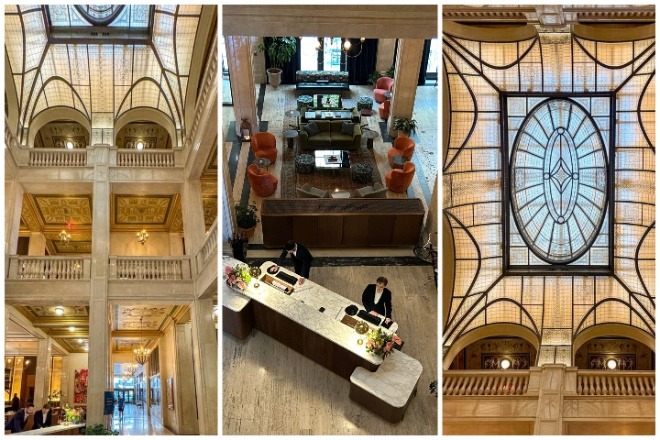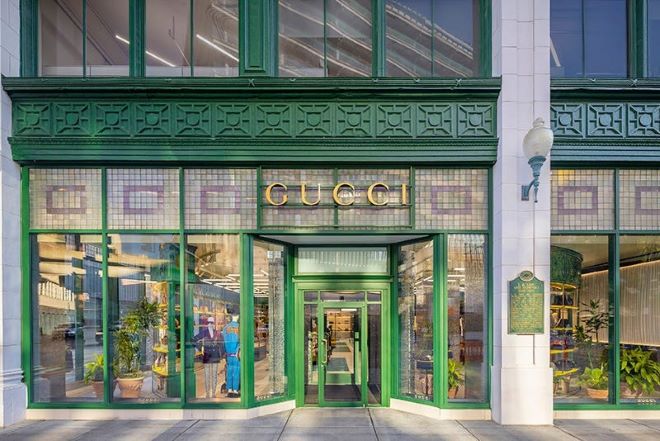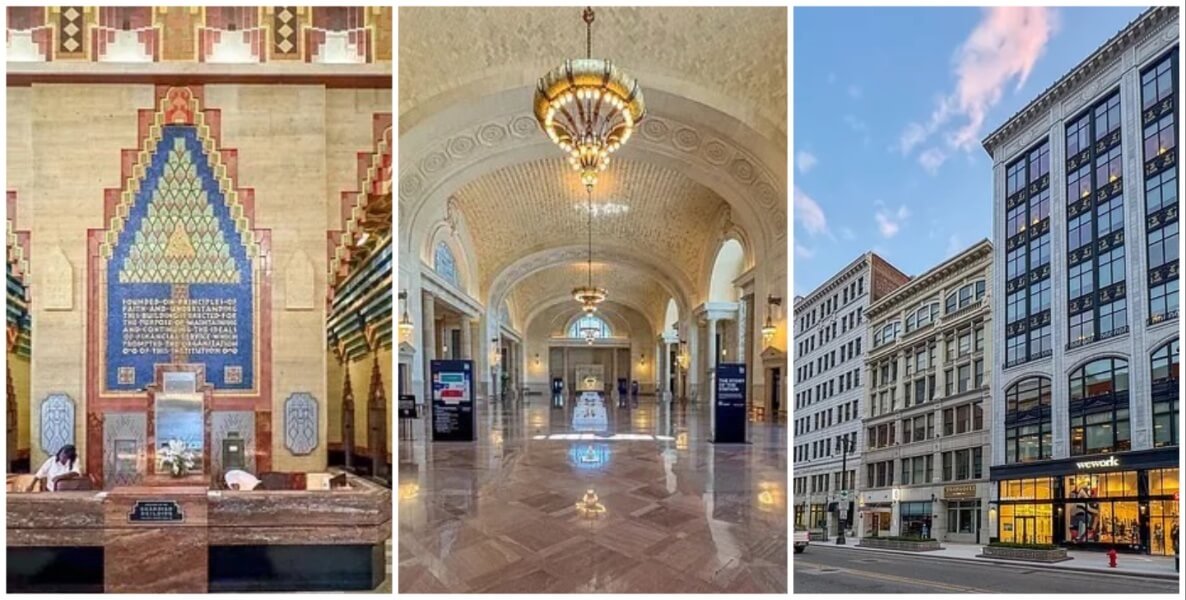I recently took a trip to Detroit with subscribers to my Substack and toured some of the city’s newest developments. I first visited Detroit in 2008, when downtown was so run down that I don’t remember seeing another person walking around, not another soul on the People Mover. Now Detroit is experiencing a new era of growth and investment that is transforming downtown and many adjacent neighborhoods.
The city offers many points of inspiration, but here are five that Philadelphia’s public, private and community leaders might find useful as they consider implementing or scaling up in Philadelphia.
Detroit takes mixed-use to the next level
Our first stop was touring the seven-year, $400 million renovation of the Book Tower. The building now exemplifies a trend I’ve seen across Detroit: maximum mixed use. The building houses five restaurants, office space, an extended-stay hotel, and rental apartments. Managing this diverse use seems exhausting, but it may ultimately be the only option for buildings of this size in the future. The lobby of the Book Tower serves not only as a traditional waiting area, but also as a bar and restaurant. The common areas for hotel guests double as the rental apartments. No square inch is taken for granted.
The best mixed-use approach was also evident the next day when we visited The Shepherd, a former church that has been converted into a small cultural campus with an art gallery, sculpture garden, skateboard park, boutique hotel, and soon a restaurant and bakery. At first I saw this mixed-use approach as a way to increase the appeal of a particular project, but later I realized that providing multiple uses allows visitors to deepen their experience and find more reasons to return or extend each stay. Detroit shows how effective—and perhaps economically necessary—combining four or five uses in one project can be.
Philly certainly has its fair share of mixed-use buildings with interesting architecture—check out the Bok Building in South Philly or Sherman Mills in East Falls, to name a few. However, other attempts to revitalize grand old buildings—the Curtis Building or the Bellevue—have neither become destinations nor resonated with locals. If we want to continue to revitalize our city’s downtown, we need to put more effort into creating interesting and accessible spaces.

Detroit paves the way for a post-creative city
The first time I visited Detroit, I was there to speak at the Creative Cities Summit. Sixteen years ago, we were in the midst of an era when many cities were building museums and launching creative industries programs, believing this would revitalize their downtowns. Today, Detroit’s renaissance has certainly benefited from its strong creative economy – for example, the Book Tower’s apartments may be filled with medical students, but they are drawn to the building for its beautiful historic preservation, chic common spaces, and high-quality restaurants.
Yet despite the city’s countless creative institutions, from DIA to the Heidelberg Project and many others, Detroit has clearly defined its STEM focus. Michigan Central, a 30-acre campus that includes the spectacular renovation of a long-abandoned train station and the repurposing of a former public school building into the business accelerator Newlab, could have been positioned as a center for art and creativity. Instead, it focuses on the development, technology, manufacturing and financing of the mobility industry. Newlab sees itself as a pipeline for workforce training and growing mobility companies. For example, Grounded, an electric van company, started at Newlab and has already expanded its operations to a nearby location.
Michigan has the highest concentration of engineers in the country. Ironically, I learned this news at an art show at Michigan Central. But maybe that just proves my point: While art and design here is top-notch, whether it’s the public art downtown or the art installations at Michigan Central, it often feels like it’s in service to industry rather than its own dominant creative economy.
In Philadelphia, you only have to look at the fiasco at the University of the Arts or the Greater Philadelphia Cultural Alliance’s report on the ailing arts sector to see that the city is ambivalent about how much to support the creative industries here. Although we have a growing biotech innovation district in University City and Pennovation, we have yet to build a real pipeline from Philadelphia’s K-12 schools to startups and venture capital like Detroit has done.
Detroit’s history gives meaning to its future
It seems like there’s something being built everywhere in Detroit, and much of that development consists of repurposing historic buildings. The result is an amazing collage of architecture that’s a boost to the boxy, paneled buildings that have blighted most of our cities, including Philadelphia. And because this kind of repurposing is almost never the easiest and cheapest way to develop, that’s why there’s such pride in reinventing these spaces.
Each of our tour guides exuded pride and purpose throughout our trip, so it was no surprise that as we left Michigan Central and joined a community-focused coffee and conversation, the representatives who grew up in the area spoke about the importance of transforming the station from an eyesore into a community gathering place. New construction erases the past; here, Detroiters have the opportunity to see something painful transformed into something beautiful.
Philadelphia has beautiful historic architecture as well. But it can feel like we take it for granted as we watch unique neighborhoods like Jeweler’s Row being torn down and the preservation and reuse of many of our historic buildings in North and West Philadelphia stagnate.
Detroit relies on bling-bling
I was surprised several times by the classy, ostentatious aspects of Detroit, like the downtown Gucci store, the fact that many restaurants offer appetizers for over $50, or the $8 pastry at a corner cafe. The Hudson Site building, with its bronze decoration reminiscent of Art Deco architecture, has an intentionally luxurious feel. The new riverfront park we visited is being designed by Michael Van Valkenburgh and built by David Adjaye – famous names in the world of architecture and design. The restoration of Michigan Central, which required reopening a quarry to find the right stones for the building’s historic renewal, was a towering achievement.

Detroit doesn’t seem interested in modestly boasting about its investments in these places. It’s betting on bling-bling and raising the level of beauty and craftsmanship in public spaces. So often it feels like our built environment is devoid of decoration, but Detroit really seems to be betting on it, in a way that actually evokes historic architecture, like the opulently decorated Fisher Building downtown from its early 20th century heyday.
It would be nice if Philadelphia also showcased its design and fashion a little more, whether by making sure we don’t lose the chic retail stores we already have, like Joan Shepp and Boyds, or by encouraging more designer architecture, like the big red Schuylkill Yards East building by SHOP Architects and the narrow, curving 2301 JFK Boulevard, which add a little pizzazz to the skyline.
The importance of the long journey
In the 1970s, Detroit Mayor Coleman Young envisioned a river park stretching the 5 miles between the city’s two main river crossings. That vision is now being realized, in the mid-2020s, with the newest 55-acre stretch of park. Michigan Central is implementing a 30-year plan for the area behind the station that includes housing and even restoring rail service to the station. Newlab’s businesses are being nurtured now to thrive in the decades to come. The $400 million invested in Book Tower will pay off in a few years.
As The Citizen has extensively reported, Philadelphia has been working for decades to improve its riverfront, as well as to repair the destruction of I-95 and the Vine Street Expressway. And just last week the Rail Park announced plans to expand the small, 300-meter-long park and make it appear larger.
Detroit is focused on the long haul—a refreshing perspective in our get-rich-quick era—as is Philadelphia. While it can be amazing to watch a city transform quickly, it’s equally impressive to see slow progress sustained over the long term, across mayoral administrations and across changes in private sector leadership.
Diana Lind is a writer and urban policy expert. This article was also published as part of her Substack newsletter. The new urban order. Sign up for the newsletter Here.
![]() MORE OF THE NEW URBAN ORDER
MORE OF THE NEW URBAN ORDER

